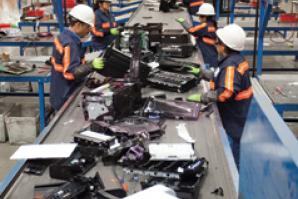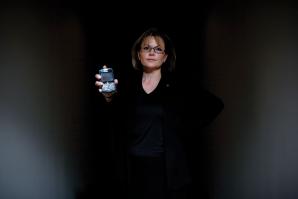Heading into the fields to check on experimental crops, an Arcadia Biosciences researcher can get a lot done with one essential tool. First, she needs to record the plot number. She takes out her tablet computer and scans the bar code attached to that plot. How have the plants changed since the last visit? She types her notes into the same tablet. That odd spot on one of the leaves might be significant. She sends a quick message on the tablet to lab colleagues back in Davis. Yes, they’d like to see it. She holds up the tablet and snaps a photo.
Tablet computers are becoming the tool of choice in multiple industries, adding convenience to simple tasks such as note taking, to more complex operations such as tracking sales. Tablets haven’t replaced laptops yet, but sales trends favor the handheld devices.
Worldwide media tablet sales are forecast to total approximately 119 million units this year, research firm Gartner Inc. reports, nearly double last year’s 60 million units sold. In four years, sales are expected to hit 369 million units.
Despite a slowdown of corporate tech spending, one in five companies surveyed in May by ChangeWave Research provides employees with tablets; 23 percent were planning to buy tablets for employees in the third quarter of this year. Thirty-five percent of companies buying or planning to buy tablets expect them to replace laptops, though that remains a central question for many consumers.
Arcadia Biosciences began its transition about two years ago with tablet products from Panasonic, Samsung and Apple. “Within a year or so, all of our folks in the field will have tablets,” says Eric Rey, firm president and CEO.
“I think they basically all do the same thing and all have more or less the same limitations, as well,” Rey says.
Nonetheless, most buyers have stronger preferences. The iPad dominates about two-thirds of the market, and even at Arcadia, the iPad is first choice among managers.
For La Shelle Dozier, executive director of the Sacramento Housing and Redevelopment Agency, the iPad replaces a thick, three-ring binder she used to lug from meeting to meeting. Now, using document-sharing site Dropbox, she can access documents as needed when she reports to governing panels and various commissions.
“I still use my desktop at work and my laptop at home,” Dozier says. “Maybe it’s because of the iPad’s size. I don’t do so much editing of documents on it. It’s just so small.”
Lois Lang found the iPad a good solution to an annoying work problem. A partner with Evolve Partner Group in Stockton, Lang holds training sessions with about six chief executives at a time.
“Handouts are always a challenge,” she says. “If I would give them a package of 20 pages, some people are flipping forward, others are flipping back, some are not paying attention.”
Now she puts everything on an iPad and hands each participant an
iPad connected to hers with the Reader application.
Worldwide media tablet sales are forecast to total approximately 119 million units this year. — Gartner Inc.
“When I move to page 10, it moves theirs to page 10. I can highlight items, and they see what I am talking about,” Lang says, who takes her personal Wi-Fi hot spot to make sure they all stay connected.
Her solution didn’t come cheap. Even stripped-down iPads get
pricey when several are purchased at once, and Lang bought 15.
“There are still times when I will use my desktop, but it is becoming more and more rare,” she says. By the start of 2013, Lang expects to have transitioned completely to handheld.
Martha Mapp made an iPad an integral part of her Italian espresso truck, Offa The Mappa. She plugs in a Square credit-card reader and it becomes her cash register.
“It tracks everything you sell,” she says. Electronic transactions end up in the bank account the next morning. “It’s just a beautiful thing.”
The tablet isn’t a panacea. It’s not the most convenient format for jobs that require lots of typing.
“I’m a pretty fast typist, and I can’t type fast on the iPad if I use the on-screen keyboard,” Arcadia Biosciences’ Rey says.
Jesse Ocampo, a provisioning supervisor for phone company SureWest, uses his iPad mostly for general administrative work.
Thirty-five percent of companies buying or planning to buy tablets expect them to replace laptops.
— ChangeWave Research
“I use the iPad for email, my calendar and note-taking in meetings. Instead of printing meeting agendas, I just view the meeting agenda on my iPad,” he says. Thanks to a virtual private network he can even use the iPad to get into his desktop computer and control it.
But for hard-core work he goes back to his desktop.
“A lot of things that I can’t do are directly related to tools that are specific to the job function,” he says, such as activating phone switches or adding features to a customer phone line.
SureWest also is a bit anxious about security on tablets, a common concern. Ocampo isn’t allowed to use Wi-Fi in the building. Instead he must log onto the in-house network.
Likewise, Matt Lerwill can’t rely entirely on his iPad as vice president of management information services at American River Packaging in Sacramento.
“I code all sorts of Web pages; I do database queries,” he says. A desktop or laptop is simply a better tool with its bigger screen and heavy-duty processor.
Lerwill says he uses his iPad as an accessory to concentration.
“If I have a thought and I need to expand on that thought or take the idea a little further, I go straight for the iPad,” he says. “It’s a great tool. There is a lot that I would like to have come from it. The more they expand it the more I see it becoming a day-to-day business tool.”
Not everyone insists on an iPad. Attorney Jeb Burton has both an iPad and a Dell tablet.
“Truthfully, I like the iPad better. I utilize it more often. But there are certain things iPad is not set up to do,” Burton says. It’s his choice for speaking engagements, using a mini-router and Apple TV to project presentations into the room. For accessing files, such as negotiating a case away from the office, he prefers the Dell.
It will take a few years more before tablets can become standard tools for lawyers, Burton says. Like other electronics, tablets aren’t allowed in some courtrooms. There are other corporate-culture hurdles.
“I’ve got people in my own firm who have been practicing over 50 years,” Burton says. “When you ask them to adopt new technology all through the practice, it’s a difficult thing.”
When the job is primarily to take notes, a tablet might suffice. Jack Crawford, general partner with Velocity Venture Capital, ditched his yellow legal pads in favor of an iPad late last year.
“Now if someone says, ‘What did we talk about back in April?’, I’ve got the last four or five board meetings all loaded onto my iPad,” Crawford says. He also can immediately mail meeting notes to his colleagues.
A tablet is also a lot less intrusive than a laptop at lunch meetings, he adds.
The tablet has advantages over other devices, but many people don’t see the need to limit themselves to a single screen at a time.
“There is a whole area that is quite interesting to me. It’s called the second-screen experience: When you are watching NFL football on your television, but on your iPad you are looking at your fantasy football players,” Crawford says. “I expect a lot more of that in the future.”
Tap a Winner
Choosing the right tablet
The iPad may be the best-selling tablet computer, but it wasn’t the first, and the number of competitors grows each year. Here are a handful of brands that can boast strong sales, high ratings or both.
Apple
About two-thirds of tablet computers sold are Apple iPads (the
specific percentage varies from quarter to quarter). Prices start
at $400 for a stripped-down iPad 2 and rise to $830 for a new,
fully loaded model. Other companies tout their machines primarily
as entertainment devices, but Apple aims at the business
demographic as well, challenging consumers to “See Your Business
Like Never Before.” There are some things the iPad won’t do on
its own — like play nice with Microsoft Office products. But
there are apps for that. One of the more popular is Documents To
Go, which gives users access to Excel spreadsheets, Word
documents and PowerPoint presentations.
Samsung
Don’t be fooled by Samsung’s consumer-grade Galaxy tablet. Billed
as “The Ultimate Entertainment Companion,” the Galaxy gets only
average ratings, and its appeal comes primarily from its $250
price tag. Samsung’s business tablet is a different story. That’s
the Series 7 Slate, the “Desktop in a Tablet,” and it’s priced
from $1,100 to $1,350. PC Magazine says, “Samsung has packed an
entire Intel Core i5 laptop into a slim, light slate tablet. Too
bad it had to pack a fan in there, too.” Fans are noisy.
Samsung is the No. 2 tablet seller, but it’s a far distant second-about 10 percent market share.
Google
With the slogan “The Playground is Open,” the Google Nexus isn’t
aiming for the executive suite. Google targets a demographic that
wants games, songs, movies and TV shows, and only wants to pay
about $200. Tech website CNET calls it “easily the best 7-inch
tablet available and one of the top tablets on the market,”
citing a good-looking screen, fast performance and a comfortable
design.
About two-thirds of tablet computers sold are Apple iPads. Samsung is the No. 2 tablet seller, but it’s a far distant second — about 10 percent market share.
Asus
Like Samsung, Asus has a split personality. “Infinite Entertainment Awaits” with its Transformer Pad Infinity. But the companion Eee line is all business. It touts a mobile dock with a standard keyboard, so tablet becomes laptop in an instant.
At about $400, it gets reviews comparable to a low-price Android tablet. The dock is extra, of course.
Toshiba
Engadget’s review calls the Toshiba Excite 13 “a big-screened
tablet with a price to match.” Where most tablet screens are 7 or
10 inches, Toshiba offers one that measures 13 inches for about
$650. (Toshiba sells smaller sizes too.) But if the whole point
of a tablet is packing a computer into a small package, you might
feel a little silly whipping out this big device to snap a photo.
But if you need a big display and don’t plan on lugging the thing
around, the size might be an advantage.
Sony
What’s notable about the Sony Tablet S is what you don’t get for
the $325 to $425 price tag: cellular connectivity. It’s Wi-Fi
only. Its wedge shape tilts the screen 4 degrees toward the user
when the tablet is sitting on a flat surface. The fat end also is
supposed to make it easier to hold with one hand. If your job
involves dealing with a bunch of other devices, this tablet also
can act as a universal infrared remote.
Recommended For You

Tech Trash
How to dispose your out-of-date computers and e-waste
If your IT room is starting to look like a scene out of “Sanford and Son,” you’re not alone. In 2010, American consumers and businesses unloaded 40 million computers onto recyclers, landfills and the refurbished market, the Golisano Institute for Sustainability in Rochester, N.Y., reports. Some estimates show, however, that millions more are idling in homes and offices because owners simply don’t know what to do with them.

Info Mobile
How smart phones are changing the face of business
Late on a work night, Amy Mathews picked up her ringing BlackBerry to find a frantic customer on the other end. On an airplane nearing departure for Buenos Aires, a woman realized her debit card was on the verge of expiration. She would be out of the country for weeks without an easy way to access cash. Mathews knew she held the solution in her palm. From her BlackBerry, the corporate banking manager at Mechanics Bank fired off a couple emails and got a new debit card ordered in minutes.



